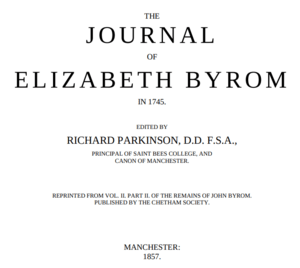Elizabeth Byrom facts for kids
Quick facts for kids
Elizabeth Byrom
|
|
|---|---|

Byrom's 1745 diary published and edited by Richard Parkinson
|
|
| Born | 1 January 1722 |
| Died | 2 December 1801 (aged 79) |
| Nationality | British |
| Known for | her diary |
Elizabeth Byrom, also known as Beppy Byrom, was a British woman who lived a long time ago (from 1722 to 1801). She is famous because she kept a diary in 1745. In her diary, she wrote about her support for the Jacobites, who wanted to put a different king on the throne of Britain. Her family also strongly supported the Jacobites. Her diary was later published in 1857.
Contents
Elizabeth Byrom's Life Story
Elizabeth Byrom was born on January 1, 1722. She was baptized at Manchester's main church, which is now called Manchester Cathedral. She was the first of four children born to her parents. She was named Elizabeth, just like her mother.
Her father was John Byrom, a poet. He was known for creating a special way of writing quickly called shorthand. Elizabeth also had a brother named Edward Byrom. Her education was paid for by money left to her by her grandfather and uncle.
Her Famous Diary and the Jacobites
Elizabeth became well-known because of a diary she started on August 14, 1745. In it, she wrote about everyday tasks. More importantly, she wrote about her excitement for Bonnie Prince Charlie. He was a prince who wanted to become King of Britain. He had landed in Scotland on July 23, 1745.
On November 28, "Charlie" and his Jacobite followers arrived in Manchester. They stored their cannons on land owned by Elizabeth's uncle, Edward Byrom. This land is now where Byrom Street and Artillery Street are located.
Elizabeth's diary shows how much she supported the Jacobites. She wrote that she ordered a blue and white dress. These were the Jacobite colors. She also bought bright garters with a special message supporting the cause. On November 30, she was thrilled to meet Bonnie Prince Charlie at Salford Bridge and even kissed his hand!
Continued Support for the Jacobites
Elizabeth continued to support the Jacobite cause even when their army decided to turn back at Derby on December 6. She and her sister helped raise money. They also visited eighteen Scottish soldiers who were held in Manchester.
She was still supporting "Charles III" (Bonnie Prince Charlie) many years later. This was even after the Jacobites declared him King in 1768. Later, she bought a teapot decorated with a white Stuart Rose and the letters "C.R. III." These were symbols of the Jacobite cause.
Later Life and Her Legacy
Elizabeth Byrom eventually became the owner of a place called Kersal Cell. She passed away there on December 2, 1801. The original handwritten copy of her 1745 diary was later found in that very building.
In 1857, a man named Richard Parkinson published her diary. He added his own notes to help explain it. Thanks to him, we can still read Elizabeth's exciting story today!


